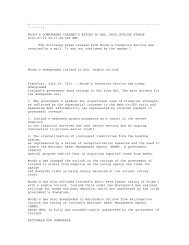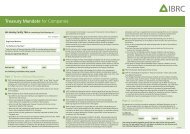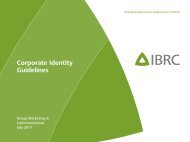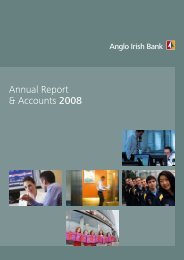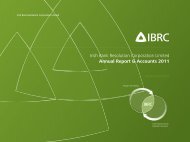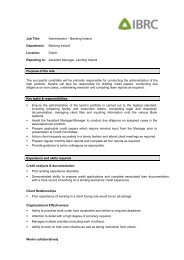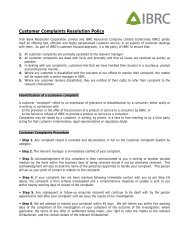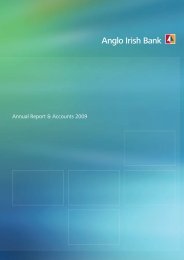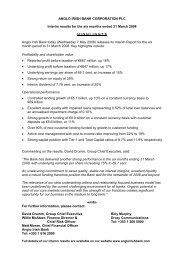Principal risks and uncertaintiesThe Group is subject to a variety of risks and uncertainties inthe normal course of its business activities. The Transparency(Directive 2004/109/EC) Regulations 2007 require a descriptionof the principal risks and uncertainties facing the Group.The Board of Directors and senior management have ultimateresponsibility <strong>for</strong> the governance of all risk taking activity andhave established a framework to manage risk throughout theGroup. Details of the risk management policies and processesthat the Group adopts are contained in note 50 to the financialstatements.The business risks and uncertainties below are those riskswhich the Directors currently believe to be the material andprincipal risks to the Group. The precise nature of all the risksand uncertainties that the Group faces cannot be predictedand many of these risks are outside of the Group’s control. Theprincipal risks and uncertainties outlined below should be readin conjunction with the Chairman’s statement and the GroupChief Executive’s review.General economic conditionsThe Group’s results are influenced by macroeconomic andother business conditions in the Group’s three historicalmarkets: Ireland, the UK and, to a lesser extent, the US.Some sectors in Ireland have sustained their contribution toexport-led growth but, overall, economic conditions in Irelandremain challenging and consequently the results of the Grouphave been adversely affected. Ireland continues to experiencesubdued consumer confidence, high unemployment, andweaker domestic commercial activity. In the short term,austerity measures introduced in consecutive budgets continueto define domestic business sentiment and inhibit personaldisposable income and spending. Such measures, which <strong>for</strong>mpart of the overall adjustment programme <strong>for</strong> Ireland, haveimproved the country’s competitiveness.Further deterioration in property prices could further adverselyaffect the Group’s financial condition and results of itsoperations. The Group’s financial per<strong>for</strong>mance may also beaffected by future recovery rates on assets and the historicalassumptions underlying asset recovery may no longer beaccurate given the general economic situation.While there has been some improvement in the UK and US,conditions remain uncertain surrounding the sustainability ofboth the global and relevant regional economic recoveries,particularly if fiscal and monetary supports are withdrawn. Inthe UK, the modest economic recovery is still exposed tochanges in UK Government policy initiatives designed to fostergrowth, which in turn could impact negatively on the broaderdemand <strong>for</strong> goods and services. As a result, unemploymentcould increase and residential and commercial property wouldagain suffer decreases in value.Government policy and restructuring riskAs the <strong>Bank</strong>’s only shareholder, and under legislative powersrelevant to the <strong>Bank</strong>, the Minister <strong>for</strong> Finance is in a position toexert significant influence over the Group. The <strong>Bank</strong> is alsowholly reliant on the support of the <strong>Irish</strong> Government.Government policy in respect of both the <strong>Bank</strong> and the widerfinancial services sector has a major impact on the Group.Changes to government policies or the amendment of existingpolicies could adversely impact the financial condition andprospects of the Group.For instance, if new governmental policies were to require the<strong>Bank</strong> to resolve its position over a shorter than expected timeframe, projected asset recovery values could be negativelyimpacted.Also, due to the substantial package of assistance <strong>for</strong> Irelandagreed between the Government, International Monetary Fund(‘IMF’) and the European Union (‘EU’) in November 2010,which included agreements to reorganise and restructure the<strong>Irish</strong> banking sector, the IMF and the EU retain significantinfluence on the future of the <strong>Bank</strong>. The <strong>Bank</strong> also remainssubject to risks which could result from any further measuresagreed between the Government, the IMF and the EU.The Credit Institutions (Stabilisation) Act 2010 (‘CISA’), enactedon 21 December 2010 following agreement of the assistancepackage, gives broad powers to the Minister <strong>for</strong> Finance tofacilitate the reorganisation and restructuring of the bankingsystem in Ireland. In this context, the <strong>Irish</strong> Governmentsubmitted a joint restructuring plan and work-out plan inrespect of the <strong>Bank</strong> and <strong>Irish</strong> Nationwide Building Society(‘INBS’) to the European Commission (‘EC’) on 31 January <strong>2011</strong>(‘Restructuring Plan’). The Restructuring Plan had beenprepared in conjunction with the Department of Finance andthe National Treasury Management Agency (‘NTMA’).A direction order (the ‘Direction Order’) was made by the <strong>Irish</strong>High Court under Section 9 of CISA on 8 February <strong>2011</strong> underwhich the <strong>Bank</strong> was directed to (a) reduce its net lending inline with <strong>for</strong>ecasts derived from the Restructuring Plan, (b)<strong>for</strong>mulate a detailed steps plan <strong>for</strong> the rationalisation and,where appropriate, closure of the <strong>Bank</strong>’s UK offices and itsbranches in Dusseldorf, Vienna and Jersey and submit it to theNTMA by 31 March <strong>2011</strong>, (c) <strong>for</strong>mulate a detailed steps plan<strong>for</strong> the disposal of the <strong>Bank</strong>’s Wealth Management businessand submit it to the NTMA by 31 March <strong>2011</strong>, (d) <strong>for</strong>mulate inconjunction with INBS a detailed steps plan <strong>for</strong> the <strong>Bank</strong>’sacquisition of/merger with INBS and submit it to the NTMA by31 March <strong>2011</strong>, (e) transfer the remaining eligible loan assets(as defined in the National Asset Management Agency Act2009 (the ‘NAMA Act’)) to the National Asset ManagementAgency (‘NAMA’) by the later of 31 December <strong>2011</strong> or thecompletion of any ongoing litigation delaying transfer of thoseloans and (f) take certain steps in connection with an auctionprocess to be operated by the NTMA in connection with thetransfer of certain of the <strong>Bank</strong>’s deposits and assets.On 24 February <strong>2011</strong>, the <strong>Irish</strong> High Court made a transferorder under Section 34 of CISA pursuant to which the majorityof the <strong>Bank</strong>’s <strong>Irish</strong> and UK deposit books, certain NAMA bondsand the <strong>Bank</strong>’s shares in its wholly-owned deposit-taking Isleof Man subsidiary were transferred to Allied <strong>Irish</strong> <strong>Bank</strong>s, p.l.c.(‘AIB’) and AIB Group (UK) p.l.c. (‘AIB UK’) (the ‘AIB TransferOrder’). On 31 March <strong>2011</strong>, the <strong>Bank</strong> submitted the threesteps plans referred to at (b), (c) and (d) above to the NTMA.On 7 April <strong>2011</strong> the Minister <strong>for</strong> Finance issued certainrequirements (‘Ministerial Requirements’) to the <strong>Bank</strong> underSection 50 of CISA pursuant to which the <strong>Bank</strong> was obliged toimplement in all material respects, with the approval of theNTMA, the high level steps plans appended thereto in relation18
Principal risks and uncertainties continued<strong>Irish</strong> <strong>Bank</strong> <strong>Resolution</strong> <strong>Corporation</strong> LimitedAnnual Report & Accounts <strong>2011</strong>to (i) the rationalisation and, where appropriate, closure of the<strong>Bank</strong>’s UK offices and its branches in Dusseldorf, Vienna andJersey, (ii) the disposal of the <strong>Bank</strong>’s Wealth Managementbusiness and (iii) the <strong>Bank</strong>’s acquisition of/merger with INBS.The <strong>Bank</strong> was also required to prepare, in conjunction withINBS and the NTMA, a high level restructuring and work-outsteps plan, based on the Restructuring Plan (the ‘High LevelSteps Plan’) and, subject to the approval of the NTMA,implement that High Level Steps Plan, subject to any variationsdirected by the EC. The <strong>Bank</strong> is proceeding to implement theHigh Level Steps Plan, following approval by the NTMA on20 June <strong>2011</strong>.The Restructuring Plan, which was approved by the EC on29 June <strong>2011</strong>, provides <strong>for</strong> the amalgamation of the <strong>Bank</strong> withINBS and sets out in detail how the loan books of thecombined entity will be resolved over a period of up to tenyears. To ensure that the assets are managed in a wayconsistent with the resolution of the combined entity, certaincommitments are now binding upon the <strong>Bank</strong>, including acommitment that it cannot enter into new activities. AMonitoring Trustee was approved by the EC on 8 December<strong>2011</strong> to <strong>report</strong> on a quarterly basis <strong>for</strong> a period of three yearson the Group’s adherence to these Restructuring Plancommitments.The <strong>Bank</strong> has prepared an operating plan which is intended to<strong>for</strong>m the basis <strong>for</strong> the implementation of the RestructuringPlan and the High Level Steps Plan. The operating plan focuseson accelerated deleveraging of the <strong>Bank</strong>, and includes theaccelerated disposal of its US loan portfolio and the disposal orwind-down of its Wealth Management division in accordancewith the Restructuring Plan, the Direction Order, the MinisterialRequirements and the High Level Steps Plan. The initiatives aresubject to operational challenges and market dependencies inrespect of timing and optimal pricing, which will increase theexecution risk of the operating plan.Note 57, Events after the <strong>report</strong>ing period, confirms that on30 January 2012 the <strong>Bank</strong> announced that the Board hadapproved a strategy and direction put <strong>for</strong>ward by managementto wind down its Wealth Management business in an orderlyfashion. This process is currently underway and may include aco-sourcing arrangement. Any final agreement reachedbetween the parties will have operational risks associated withthe process.Ratings downgrades – <strong>Bank</strong> and SovereignDuring <strong>2011</strong>, the <strong>Bank</strong>’s long-term Standard & Poor’s (‘S&P’)counterparty credit rating was downgraded by three notchesto CCC and remains below investment grade. Similar actionwas taken by Moody’s during the period (rating cut from Ba3to Caa2) and by Fitch (rating cut from BBB- to BB-). In takingthese rating actions, credit rating agencies cited concernsabout the <strong>Irish</strong> Government’s publically indicated preference toimpose losses on the Group's senior unsecured andunguaranteed debt holders.Eurozone riskDuring <strong>2011</strong>, the economic, monetary and political uncertaintyin a number of eurozone members increased. The cost andavailability of funding available to European banks, includingthe Group, may be affected by any further escalation of thesovereign crisis, and could also materially adversely affect theGroup’s financial condition and results of operations due tothe impact on economic conditions in the eurozone and theEuropean Union in general.Liquidity and funding riskLiquidity and funding risk is the risk that the Group does nothave sufficient financial resources available at all times to meetits contractual and contingent cash flow obligations or canonly secure these resources at excessive cost. This risk isinherent in all banking operations and can be affected by arange of institution-specific and market-wide events. TheGroup’s liquidity may be adversely affected by a number offactors, including significant un<strong>for</strong>eseen changes in interestrates, ratings downgrades, higher than anticipated losses onloans and disruptions in the financial markets generally.In response to major market instability and illiquidity,governments and central banks around the world haveintervened in order to inject liquidity and capital into financialmarkets and, in some cases, to prevent the failure ofsystemically important financial institutions. These variousinitiatives to stabilise financial markets are subject torevocation or change, which could have an adverse effect onthe availability of funding to the Group.In common with many other banks, the Group’s access totraditional sources of liquidity remains constrained. The <strong>Bank</strong>has experienced greater reliance on Government and monetaryauthority support mechanisms due to the AIB Transfer Orderand the maturity of debt securities. The <strong>Bank</strong>’s continuedreliance on support from central banks includes access tospecial funding facilities, a key factor in ensuring successfulimplementation of the operating plan as well as adapting topotential regulatory developments. The funding support fromcentral banks and monetary authorities amounted to €42.2bnat 31 December <strong>2011</strong>, representing 87% of total funding, andincluded €40.1bn borrowed under special liquidity facilities.This support increased from December 2010 (70% of totalfunding) following the transfer of certain <strong>Irish</strong> and UK depositsand NAMA bonds to AIB and AIB UK under the AIB TransferOrder.Should monetary authorities materially change their eligibilitycriteria or limit the <strong>Bank</strong>’s access to such special fundingfacilities without providing an alternative funding source, thiswould adversely affect the Group’s financial condition andprospects. Additionally, credit rating downgrades may impacton the eligibility of assets currently pledged as collateral <strong>for</strong>central bank open market sale and repurchase agreements.Also during the period the <strong>Irish</strong> Sovereign’s senior debtsuffered further credit rating downgrades. S&P lowered theirrating from A to BBB+, Moody’s adjusted their rating fromBaa1 to Ba1, and Fitch reduced their rating from BBB+ (Stable)to BBB+ (Negative).19





